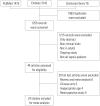Protocol-Based Resuscitation for Septic Shock: A Meta-Analysis of Randomized Trials and Observational Studies
- PMID: 27401660
- PMCID: PMC4960395
- DOI: 10.3349/ymj.2016.57.5.1260
Protocol-Based Resuscitation for Septic Shock: A Meta-Analysis of Randomized Trials and Observational Studies
Abstract
Purpose: Owing to the recommendations of the Surviving Sepsis Campaign guidelines, protocol-based resuscitation or goal-directed therapy (GDT) is broadly advocated for the treatment of septic shock. However, the most recently published trials showed no survival benefit from protocol-based resuscitation in septic shock patients. Hence, we aimed to assess the effect of GDT on clinical outcomes in such patients.
Materials and methods: We performed a systematic review that included a meta-analysis. We used electronic search engines including PubMed, Embase, and the Cochrane database to find studies comparing protocol-based GDT to common or standard care in patients with septic shock and severe sepsis.
Results: A total of 13269 septic shock patients in 24 studies were included [12 randomized controlled trials (RCTs) and 12 observational studies]. The overall mortality odds ratio (OR) [95% confidence interval (CI)] for GDT versus conventional care was 0.746 (0.631-0.883). In RCTs only, the mortality OR (95% CI) for GDT versus conventional care in the meta-analysis was 0.93 (0.75-1.16). The beneficial effect of GDT decreased as more recent studies were added in an alternative, cumulative meta-analysis. No significant publication bias was found.
Conclusion: The result of this meta-analysis suggests that GDT reduces mortality in patients with severe sepsis or septic shock. However, our cumulative meta-analysis revealed that the reduction of mortality risk was diminished as more recent studies were added.
Keywords: Sepsis; meta-analysis; septic shock; shock.
Conflict of interest statement
The authors have no financial conflicts of interest.
Figures








References
-
- Rivers E, Nguyen B, Havstad S, Ressler J, Muzzin A, Knoblich B, et al. Early goal-directed therapy in the treatment of severe sepsis and septic shock. N Engl J Med. 2001;345:1368–1377. - PubMed
-
- Zambon M, Ceola M, Almeida-de-Castro R, Gullo A, Vincent JL. Implementation of the Surviving Sepsis Campaign guidelines for severe sepsis and septic shock: we could go faster. J Crit Care. 2008;23:455–460. - PubMed
-
- Castellanos-Ortega A, Suberviola B, García-Astudillo LA, Holanda MS, Ortiz F, Llorca J, et al. Impact of the Surviving Sepsis Campaign protocols on hospital length of stay and mortality in septic shock patients: results of a three-year follow-up quasi-experimental study. Crit Care Med. 2010;38:1036–1043. - PubMed
-
- ARISE Investigators; ANZICS Clinical Trials Group. Peake SL, Delaney A, Bailey M, Bellomo R, et al. Goal-directed resuscitation for patients with early septic shock. N Engl J Med. 2014;371:1496–1506. - PubMed
Publication types
MeSH terms
LinkOut - more resources
Full Text Sources
Other Literature Sources

